教学课件 国际贸易实务(第三版)黎孝先
- 格式:ppt
- 大小:810.00 KB
- 文档页数:10
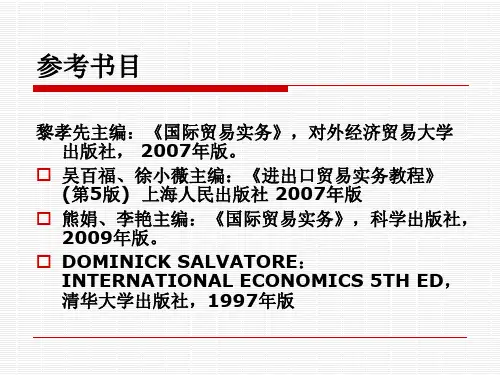
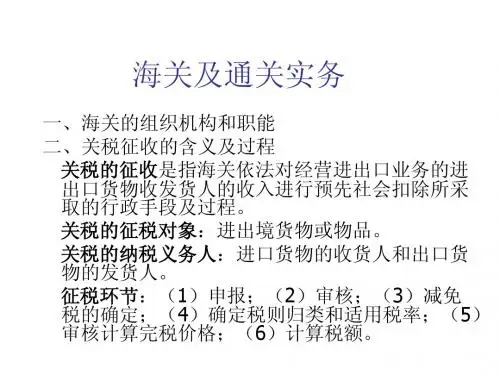
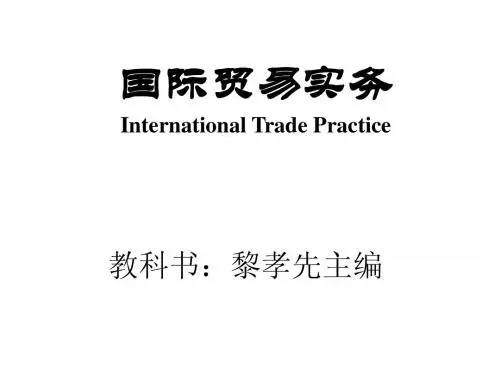
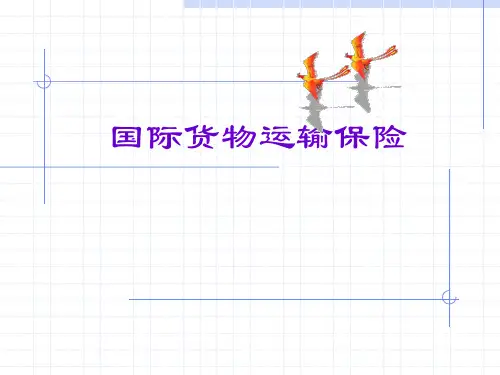

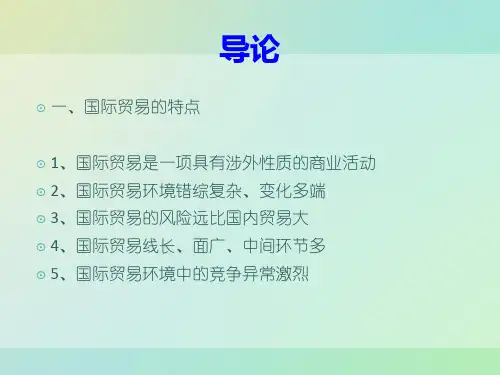
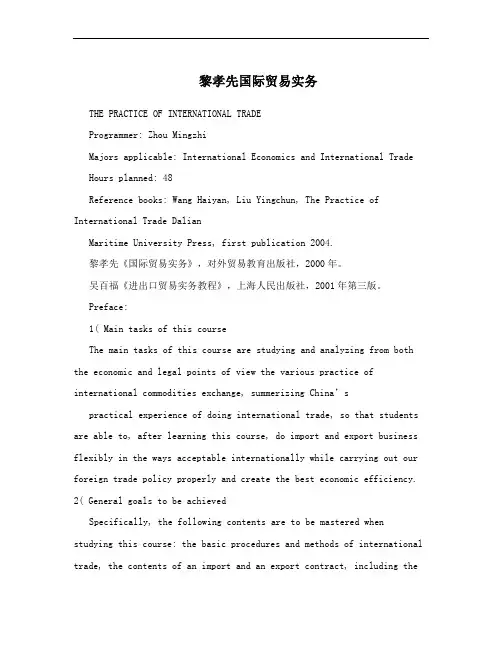
黎孝先国际贸易实务THE PRACTICE OF INTERNATIONAL TRADEProgrammer: Zhou MingzhiMajors applicable: International Economics and International Trade Hours planned: 48Reference books: Wang Haiyan, Liu Yingchun, The Practice of International Trade DalianMaritime University Press, first publication 2004.黎孝先《国际贸易实务》,对外贸易教育出版社,2000年。
吴百福《进出口贸易实务教程》,上海人民出版社,2001年第三版。
Preface:1( Main tasks of this courseThe main tasks of this course are studying and analyzing from both the economic and legal points of view the various practice of international commodities exchange, summerizing China’spractical experience of doing international trade, so that students are able to, after learning this course, do import and export business flexibly in the ways acceptable internationally while carrying out our foreign trade policy properly and create the best economic efficiency. 2( General goals to be achievedSpecifically, the following contents are to be mastered when studying this course: the basic procedures and methods of international trade, the contents of an import and an export contract, including thename and specification of commodity, the price and trade terms, transportation, insurance, payment terms, claim and arbitration, and force majeure clause, and ways of negotiating (offer, counter-offer and acceptance) and execution of an international contract. Building up the students’ actual operational ability of doing business and making out documents for settling payment is the basic requirement and the general goal of this course. 3( Principle of editingThis outline is based on the 2005 teaching program for the international economic and trade majors of ZZIA.4( Suggestions, This course should be preceded by western economics, international laws, internationalfinance and merchandizing, Case-analyzing teaching method and operation-mock aided teaching system should to beused in teaching process., More teaching ours should be added for this course when using the above teachingmethod5( Teaching ours’ arrangem entChapters Contents Total Remarkshours Class PracticeteachingChapter 1 Preface 2 2Chapter 2 Commodity and description 6 6Chapter 3 Trade terms and price 6 4 2Chapter 4 Transportation of goods 6 4 2Chapter 5 Insurance of goods in transit 4 4Chapter 6 Payment 6 4 2Chapter 7 Inspection, claims, arbitration 4 4and force majeureChapter 8 Business Negotiation and 6 4 2conclusion of a contractChapter 9 Performance of a contract 4 4Chapter 10 Modes of int’l trade, new int’l 2 2standards & E-commerce6( Main content of each chapterChapter 1 preface (2 hours)Aim of teaching:To provide the students with a general profile of this course by briefly introducing the development of international trade, the main contents and methods of teaching, the significances and ways of international trade, so as to arouse their interest in learning this course and lay a solid foundation for further teaching and studying.Content of this chapter:This course, the practice of international trade, is an applied course, which involves incontacts with foreign countries, thus foreign trade policies and international trade laws and practices as the United Nations Convention on Contracts for the International Sale of Goods andChina’s Contract Law. So, it is much more complicated, risky, time consuming and difficult than doing domestic trade. Therefore, we should keep a keen eye on the development of both international and our country’s policies and China’s foreign trade practice. Difficult and importantpoints: the characteristics of international trade.Chapter 2 Commodity and Description (6 hours)Aim of teachingStudy the ways of describing commodities in contracts and relevant laws on description. Content of this chapter:Section 1 Name of commodity and quality, The name of the commodity in a contract must be clearly defined,in detailsand with specifications if needed, and should be in conformity with international practice., The quality of goods refers to the inner quality, constructions, chemicalcontents and its outer features as color, shape and so on. Different quality andname of commodity has different value and price. The description of goodsand their quality in the contract are the basic conditions on delivery., The subsequent consequences of violation of the contract clauses of name andquality in performing contract., Ways of specifying the quality in contract(1) Sales by sample: by the sellers’, the buyers’ or counter-sample(2) Sales by description: by specifications, standard, brand, grade, origindescription in words or diagram etc.Section 2 Quantity of commodity, The clause concerning the quantity of goods is one of the most important ones in the sales contract and serves as the bases of delivering and accepting., Legal consequences of violating the quantity clause of thecontract by the sellers., Measuring units commonly used in contracts of internationalsales: the British system, American system, metric system and the international system., Ways of measuring goods by weight: gross weight, net weight,conditioned weight and theoretical weight., Quantity tolerance: approximate, more or less in quantity and price.Section 3 Packing1. Packing has the following functions: protecting cargo,facilitating handling and transportation and promoting sales. Packing can be divided into transportation packing and sales packing according to the purpose of packing. On the surface of packing, there are usually marks which are classified into shipping marks, indicative marks and warning marks. The standard shipping marks recommended by the ISO.2. Main content of the packing clause in a sales contract: packing materials, methods of packing and packing fees. The cost pf packing is usually included in the price of the goods quoted, but, if the buyer has special requirements in excess of the usual packing, the extra fees are usually born by the buyer and the contract should be so stipulated.Important and difficult points:Quality tolerance and quality latitude: conditioned weight, approximate weight and quantity latitude, shipping marks and neutral packing.Chapter 3 Trade Terms and Pricing (6hrs)Aim of teaching and requirement:Trade terms are important points in this course. Students are required to master at least the most frequently used three terms: FOB, CFR and CIF in international trade and other three newer terms: FCA, CPT and CIP which are becoming more and more popular in world trade. Students should be able to use these terms freely and make offers correctly in accordance with the international trade practices.Main content of this chapterSection 1 definition of trade terms and the relevant international practices1. trade terms are used to divide the risk liabilities between the buyer and the seller,determine the bearers of fees and the time and place of transferenceof the title tothe goods.2. the most influential international trade practices on trade terms.(1) Warsaw- Oxford Rules 1932. It was worked out and revised by the InternationalLaw Association to explain CIF term with details on the essence ofthe CIFcontract; risks, liabilities and fees born by both parties, and waysof transferenceof title to the goods.(2) the Revised American Foreign Trade Definitions 1941. It includes six trade termsand defined FOB in detail with six different definitions. It has a certain influencein North America and Latin America.(3) International Rules for the Interpretation of Trade Terms 2000-InternationalCommercial Terms for Short (Incoterms2000). This is the most frequently usedand most popular international practice in the world today. It is the latest revisionby the International Chamber of Commerce. It includes 13 trade terms that areusually divided into four groups namely the E, F, C, D group which stand forDeparture, Main carriage unpaid, Main carriage paid and Arrival respectively. Section 2 Main trade termsThis section mainly introduces six main terms: FOB, CFR, CIF, FCA, CPT and CIP of the Incoterms 2000. Under the first three terms the seller delivers when the goods pass the ship’s rail at the named port of shipment while under the last three ones the seller delivers the goods when they are handed over to the carrier nominated by him. The important points are the first three terms which are usually called “the old three terms”,but the last three ones are becoming increasingly important with the development of containerization and combined modes of transportation in international trade. 1. the three most popular terms: FOB, CFR and CIF We should pay attention to their definitions, variation forms and their difference with the explanations of FOB term in the Revised American Foreign Trade Definitions 1941.When using FOB term special attentions should be paid to thedefinition of “pass theship’s rail”, the connection of goods with the carrying vessel and the problem of bearing the fees of loading when chartering a ship.Under CFR, as the seller delivers the goods at named the port of shipment, the problem as to who bears the unloading charges should be made clear under a chartering party, and it is of vital importance for the seller to notice the buyer the exact time of shipment when completed so that the buyer won’t lost time to effect insurance for the goods delivered.With CIF, the coverage of insurance, booking shipping space, bearing of unloading fees under voyage charter party and symbolic delivery are important issues that must be clarified to both parties.2. three commonly used trade terms under which the seller deliversto the carriernominated by him.Definitions of FCA, CPT and CIPPoints to note using FCA, CPT and CIP:Different places of delivery under different modes of transportation, transfer of risks, fees and responsibilities relating to delivery under FCA;Places of transferring risks from the seller to the buyer,clarification of fees and responsibilities, difference between CPT and CFR under CPT; andCorrect understanding of risks and insurance, reasonable pricing and the difference between CIP and CIF.Section 2 Other seven trade termsThey are EXW, FAS, DAF, DES, DEQ, DEU and DDP, out of which 5 belong to arrival terms, i.e. delivered at a place in the importing country, such as the frontier, port or an inland place of the buyer’s cou ntry. They are less popular than the previous sixones although they can meet some of the needs of the dealers, and therefore not the important points of this unit.Section 3 The price clause in a sales contractImportant points: principles of pricing i n our country’s foreign trade, currencyselection, value protection, ways of pricing, fixed price and non-fixed price, adjustment of price and trade terms selection.Section 4 Formation and evaluation of cost, commission and discount of import and exportFormulas used in evaluation of the cost of a product ( profit rate, foreign exchange earning cost rate); commission and rebate, commission included price and net price. Key and difficult points:The six most commonly used trade terms—FOB, CFR, CIF, FCA, CPT and CIP; pricechanges with the use of different trade terms; evaluation of cost of import and export.Chapter 4 International cargo transportation (6hrs)Aim of teaching and requirement:Transportation is one of the most key procedures in international trade. Students are require to learn in this chapter knowledge about different modes of transportation, calculation of freight, shipping documents and procedures in effecting international trade.Main content:Section 1. Modes of transportation and their featuresMarine transport, railway transport, transport by air, by container and multimode transport.Section 2 Marine transportLiner transport, charter transport; ways and standard of calculating liner freight. Section 3 Shipping documentsDifferent shipping documents and their characteristics underdifferent modes of transport; the essence, classification and characteristics of ocean bill of lading. Key points: on board B/L, clean B/L, direct B/L, to order B/L, ante-dated B/L and advanced B/L Section 4 The transportation clause in a foreign trade contract.Shipping and delivery, symbolic delivery, port/place of loading and port/place of discharge(or port/place of shipment and port/place of destination); shipping validity and shipping advice; demurrage and discharge money.Key and important points:Liner transport and charter transport, liner’s freight, demurrage and discharge money,ocean B/L, actual and symbolic delivery.Chapter 5 International Cargo Transportation Insurance( 4hrs)Aim of teaching and requirement:Insurance is one the indispensable key links in international trade. Contents to be mastered in this chapter are: the character of insurance, different liabilities of different coverage of risks, procedures of taking insurance and premium calculation. Main content:Risks covered by marine transportation insurance; loses and fees; insurance categories undertaken by PICC; premium calculation, warehouse to warehouse clause. Section 2 Insurance of other modes oftransportationOverland transportation, aviation transportation insurance post parcel insurance Section 3 Insurance documents and practices Insurance policy and insurance certificate, open policy andinsurance clause in a contract.Key and difficult points:Risks and loses, CIC and ICC insurance clauses, warehouse to warehouse clause and insurance documents.Chapter 6 International Payment (8hrs)Aim of teaching and requirement:Payment of proceeds is another key part of this chapter. So, after learning this chapter, students are required to have a thorough knowledge of the different terms of payment, including theircharacteristics and usual practices as well as the stipulations of a payment clause in a contract.Main content:Payment is one the most important concerns of both parties to a contract. Contents in this part include payment documents, types of payment and time of payment. Section 1 Payment tools (documents) International payment and settlement are usually conducted through transference of commercial and/or financial documents (rather than by the flow of cash) and among those financial documents draft is the most popular one.Definition of draft, indispensable parts of a draft, circulation of a draft, transfer, discount, dishonor and recourse of a draft, document law and international trade practices are important parts of this chapter.A brief introduction of promissory note and checksSection 2 Remittance and collectionRemittance, collection and L/C are the three main payment methods commonly use d in our country’s foreign trade apart from a minor part by inter-government accounts on the bases of payment settlement agreements between our country and a few other countries.Remittance is a one- way method, which means that the draft flowsthe same direction as the money. In this way, the buyer take the initiative to remit the money directly to the seller. Remittance belongs to commercial credit. It includes mail transfer(M/T),telegraphic transfer(T/T) and demand d raft(D/D). In international trade, it is usually used to remit advance payment, down payment, sample fees and commission, etc. Collection is a return method which means that the creditor (usually the seller) issues a draft and entrusts a local bank to send it to a relative bank or its bran ch in the debtor’s country to collect the money from the debtor (usually the buyer). It also belongs to commercial credit.Collection should be conducted in compliance with the Uniform Rules for Collection, ICC Publication No.522 (URC 522).Documentary collection is more popular than clean collection in international trade and documents against acceptance (D/A) is riskier than documents against payment (D/P) to the seller.Section 3 Letter of CreditLetter of credit (L/C) payment is also a return method. In L/C payment the issuing bank takes the primary liabilities for payment and thus L/C payment belongs to bank credit. There might be eight parties to an L/C.The basic procedure of L/C paymentThe characteristics of L/C payment: the issuing bank has the primary and independent liabilities for payment; an L/C is a self-sufficient instrument although it is issued on the bases of a sales contract; anL/C is simply a document transaction; documents must be strictly incompliance with the relevant L/C with each other.Ls/C can be classified into many different types based on their characteristics, forms, time of payment and usages.Main contents of Uniform Customs and Practice for Documentary Credit 1993 Revision (ICC Publication No.500)Content of L/C payment clause: time of issuing, type of L/C, date of payment, amount of L/C, expiry place etc.Section 4 Banker’s Letter of Guarantee (L/G) and Standby L/CDefinition of banker’s L/G, parties to an L/G, main content of it, its utilization and characteristics;Characteristics of standby L/C;The differences between banker’s L/G and standby L/C;The differences between standby L/C and documentary L/C;Section 5 other payment methods and utilization of payment methodsin a contract Other payment methods include factoring and deferred paymentIn order to facilitate a successful conclusion of a transaction, flexible utilization of payment terms and a combination of two or more payment methods can be used, such as a combination of L/C with remittance, L/C wi th collection and remittance with banker’s L/G etc.Section 6 International factoringDefinition of factoring; content of international factoring; types of international factoring; procedures of international factoring; export factoring agreement. Key or difficult points:Payment instruments and methods, financial documents and utilizationof financial documents, L/C and banker’s L/G. International factoring Chapter 7 Inspection , claims, arbitration and Force Majeure (4hrs) Aim of teaching and requirements:To introduce to the students the provisions and some knowledge on inspection, claims arbitration and Force Majeure which are usually included in the sales contract as clauses.Main content:Section 1 Inspection of commoditiesIn international trade, inspection refers to inspection or authentication conducted by a third qualified party as arranged on the goods sold or to be sold so as to determine their quality, quantity and packing as to whether they are up to the standard or provisions in the sales contract. Documents issued by the inspection party can be used as evidences of delivery, payment or claims and settlement of claims.Contents of an inspection clause in the international sales contract: Provisions on the title of inspection, time and place of inspection and reinspection, inspection institutions, inspection certificates, inspection standard and method. In an international sales contract, the inspection clause usually stipulates that inspection be conducted in the seller’s country and reinspection in the buyer’s country.A brief introduction of the Inspection Law of the People’s Republicof China on theImport and Export Commodities.Section 2 Claims and settlement of claimsClaim refers to the act of the affected party asks the liability party for compensation for the loses he sustained while settlement of claims refers to the act of accepting the claims.There are two kinds of claims in international sales contract: oneis discrepancy and claim clause, mainly including evidences and validity of claim, and the other is penalty clause which stipulates if one party fails to fulfill its obligation, he must pay an appointed amount of penalty to the other party. Penalty clause primarily applies to cases as the seller’s delay in delivery, the buyer’s delay in opening the L/C and inpayment.Section 3 ArbitrationThere are generally four ways in settling international disputes: friendly negotiation, mediation, arbitration and lawsuit.International arbitration is conducted on the bases of an agreement between both parties in which stipulates that they are willing to submit to the arbitration institution in case of a dispute arises and cannot be settled through friendly negotiation, and that the arbitration award is final and binding upon both parties.Arbitration agreement is the basis on which the arbitrationinstitution accepts the case. It can be made in advance in the form of an arbitration clause in the contract or after a dispute has occurred. Main contents of an arbitration clause includes: place of arbitration,selection of arbitrators and arbitration institution, arbitration procedures,authentication of arbitration and bearing of arbitration fees.Execution of an arbitration award; the UN Convention on the Recognition and Enforcement of Foreign Arbitral Awards.Section 4 Force Majeure clause in the contractForce Majeure refers to those accidents or natural calamities happened after the conclusion of the contract that not for the reason of the negligence or mistakes of the party but because of those natural or social forces that cannot be controlled, anticipated, or overcome by the party, and on account of which the contract cannot be executed further or completely. In this case, the affected party is exempted from bearing liabilities of executing the contract.Content of Force Majeure clause in the contract:The range of Force Majeure, the consequence of it, period and method of notification of such a case to the other party, evidential documents required and institutions issuing such documents.Key or difficult points:The authentication of inspection, claims and settlement of claims, Force Majeure clause.Chapter 8 Business Negotiation and Conclusion ofinternational sales contract (8hrs)Aim of teaching and requirements:Students are required to learn the techniques and skills of business negotiation and all the legal procedures and practices in concluding an international sales contract. Main contents:Business negotiation involves profound knowledge in politics, strategies and technology andthus should get well prepared before starting one. Preparation may include selection of negotiationgroup members, clients, market, making out operation and negotiation plans.Section 1 business negotiationBusiness negotiation can be carries out through face to face talk or exchange of correspondence like letters, faxes, phone calls and e-mails or through a combination of both. Contents of business negotiation include all the business terms and conditions in regard to the sales contract (quality, quantity, packing, price, shipment, insurance, payment, inspection, claims, arbitration and Force Majeure). The negotiation procedures generally consists of enquiry, offer, counter-offer and acceptance, in which offer and acceptance are indispensable.1. offer:Conditions for an offer, the implications of offer, its legal effect and ways of expressing, validity of offer, withdrawal or cancellation of offer; implication of counter-offer, its legal effect and ways of making counter-offers.2. acceptance:Definition of acceptance, conditions for acceptance, conditioned acceptance andacceptance with non-critical variation of conditions, going into effect of acceptance and withdrawal of acceptance.Section 2 Award of contractContent s of a written form of contract and contract’s roleKey or difficult points:Offer and acceptance.Chapter 9 Execution of import and export contract (4hrs)Aim of teaching and requirements:Students are required to learn skills and knowledge about the contents of procedures and methods in execution of import and export contract.Main contents:Section 1 Execution of export contractIn doing international trade, it is preferable for the seller to conclude the contract under CIF or CFR terms and payment by L/C. Executing an export contract can be divided into the following four steps: getting the goods ready (including having the goods inspected ), opening the L/C (including urging the buyer to open the L/C, checking the L/C and amendment of it), arranging shipment and settlement of payment(including making out documents and presenting to the bank for negotiation).Section 2 Executing an import contractIf the import contract is concluded under FOB term and payment byL/C, which is usually followed in our import trade, the procedures of executing it should include the following steps: opening L/C, arranging shipment, i.e. to book shipping space or send a ship or ships to pick the goods, covering insurance, clearing customs and taking delivery of goods, having the goods inspected and transferred to the end users, lodge a claim or submit for arbitration if any disputes arise and cannot be settled through friendly negotiation.Key or difficult points:Knowledge and skills on the execution of import and export contract.Chapter 10 Modes of international tradeAim of teaching and requirements:This chapter offers other modes of international trade apart fromthe most popular and traditional buying and selling method, so that learners of international trade will have a broader mind in developing trade in the future.Main content:Section 1 Exclusive salesDefinition of exclusive sales, relationship between the two parties to the contract of exclusive sales, the nature of such a contract, main contents of exclusive agreement and pros and cons of this method.Section 2 AgencyDefinition of agency, relationship between the agent and the principal, types of agency,exclusive agency, general agency and commission agency, maincontents of agency agreement.Section 3 Open Account sales (O/A)Definition and characteristics of O/A, difference between O/A and agency, main contents of an O/A agreement.Section 4 Tender and biddingDefinitions of tender and bidding, general procedures of tender and bidding, main contents of tender and bidding documents.Section 5 AuctionDefinition and characteristics of auction, general procedures of auction, way of bidding.Section 6 HedgingCharacteristics and nature of hedging in international trade, types of hedging, hedging and price transfer risks.Section 7 Barter tradeDefinition of barter trade and its development, modes of barter trade: exchange of goods, counter purchasing, compensation trade.Section 8 Processing supplied material and assembling supplied parts and components.Processing supplied or imported material and assembling supplied or imported parts and components and then export the finished products is a kind of labour trade through which the processing and assembling party receives the processing and assembling fees only. The pros and cons of this kind of trade.Section 9 Introduction to ISO9000, ISO14000, SA8000 and E-commerce Key and difficult points:The difference between traditional way of trading and those flexible ways of trading.。

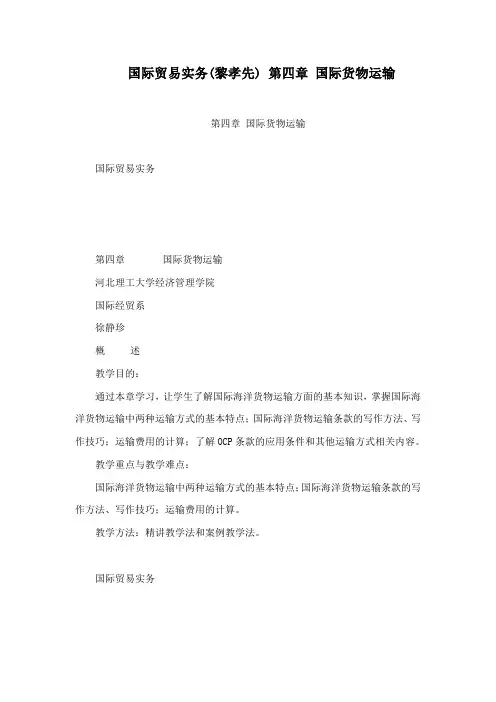
国际贸易实务(黎孝先) 第四章国际货物运输第四章国际货物运输国际贸易实务第四章国际货物运输河北理工大学经济管理学院国际经贸系徐静珍概述教学目的:通过本章学习,让学生了解国际海洋货物运输方面的基本知识,掌握国际海洋货物运输中两种运输方式的基本特点;国际海洋货物运输条款的写作方法、写作技巧;运输费用的计算;了解OCP条款的应用条件和其他运输方式相关内容。
教学重点与教学难点:国际海洋货物运输中两种运输方式的基本特点;国际海洋货物运输条款的写作方法、写作技巧;运输费用的计算。
教学方法:精讲教学法和案例教学法。
国际贸易实务第四章国际货物运输第一节运输方式主要的运输方式有:海洋运输、铁路运输、航空运输、邮政运输、联合运输等据美国运输杂志统计:各种运输方式的货运量分别占:我国:海运货物运输量75-80% 85-90%相邻国路上运输量 20-22% 5-8%航空运输2-3% 2-3%其他(管道运输等)1-2% 1-2%第四章国际货物运输第一节运输方式一、海洋运输(一)? 海洋运输的基本知识1、海洋运输的特点运载量大通过能力强运费低货物的适应性强航行速度慢风险较大第四章国际货物运输第一节运输方式一、海洋运输2、海洋运输的船舶种类1)? 干货船Dry Cargo Ship(1)?????? 杂货船 General Cargo Ship (2)?????? 干散货船 Bulk Cargo Ship(3)?????? 冷藏船 Refrigerated Ship(4)?????? 木材船 Timber Ship(5)?????? 集装箱船 Container Ship----(<#004699'>6)?????? 滚装滚卸船 Roll on/Roll off Ship (7)?????? 载驳船 Barge Carrier“拉希”型:LASH:Lighter Aboard Ship“西比”型:SEABEE2)? 油槽船:(1)?油轮Oil Tanker(2)?液化天然气船 Liquefied Natural Gas Carrier?第四章国际货物运输第一节运输方式一、海洋运输船舶的吨位:1)船舶的重量吨位Weight Tonnage排水量吨位Displacement Tonnage(1)? 轻排水量Light Displacement(2)? 重排水量Full load Displacement(3)? 实际排水量Actual Displacement载重吨位 Dead Weight Tonnage D.W.T(1)总载重吨Gross Dead Weight Tonnage(2)净载重吨 Dead Weight Cargo Tonnage---D.W.C.T2)船舶的容积吨位Registered Tonnage注册总吨:Gross Registered Tonnage----G.R.T注册净吨Net Registered Tonnage-----Net registered Tonnage---N.R.T? 第四章国际货物运输第一节运输方式一、海洋运输船籍和船旗:Ship’s Nationality and FlagFlag of convenience(二)海洋运输船舶的经营方式1、班轮运输Liner Transport(1)班轮运输:班轮运输是指船舶在固定的航线上和港口间按事先公布的船期表(Sailing Schedule)航行,从事客货运输业务并按事先公布的费率收取运费。
